The dress that made the world gasp
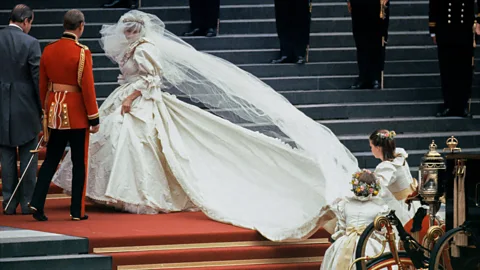
From Princess Diana’s show-stopping bridal gown to a new collection full of 80s drama, Elizabeth Emanuel has been on a ‘rollercoaster ride’. She talks to Lindsay Baker.
A voluminous taffeta ballgown made an unexpected appearance at the recent Gucci Cruise show, bringing to mind 1980s style in its full, flouncy glory. “The models looked like geeky young girls playing dress-up – it was a grunged-up version of the 1980s, a thrift-store, charity-shop version,” stylist and creative consultant Cathy Kasterine tells BBC Designed. The look was by all s intentionally awkward – and slightly tongue-in-cheek. As Kasterine, who contributes to Porter and Vogue China, puts it: “Fashion has a love-hate relationship with the 80s.”
 Getty Images
Getty ImagesGucci is not alone. The 1980s have been a source of ambivalent fascination for several designers in recent years – among them Balenciaga. Along with these is veteran British designer Elizabeth Emanuel, who has created an eclectic, contemporary version of the romantic 1980s look. Her new couture collection, Elizabeth: Paris 1902, is full of exquisite flounces, frills, ruffles and romance. And, as at Gucci, the look is opulent but also slightly off-kilter and eccentric – a fairytale look to be worn with quirky make-up and clumpy Dr Martens boots.
 Markus Lambert/ Elizabeth by Elizabeth Emanuel
Markus Lambert/ Elizabeth by Elizabeth EmanuelIf anyone is qualified to subvert this particular fantasy-princess look, it has to be Elizabeth Emanuel. Along with her then husband David, she designed the quintessential 80s taffeta gown – the famous wedding dress worn by Princess Diana in 1981.
More like this:
The marriage of Prince Charles and Lady Diana Spencer was watched by 750 million people across the world, and was an iconic moment, not least because of that dress by the Emanuels. The dramatic bridal gown was a blowsy confection of ivory silk taffeta and antique lace with 10,000 pearl beads, a 25ft (7.6m) train of tulle and lace chiffon veil. The dress was so big that it got crushed en route in the glass carriage that the bride rode in to St Paul’s Cathedral.
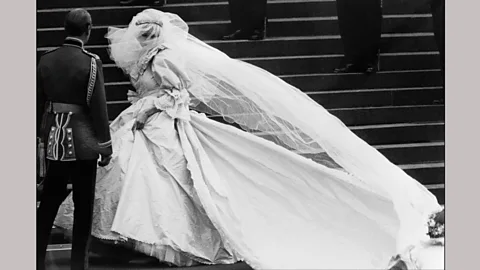 Getty Images
Getty Images“We just went for drama,” Emanuel tells BBC Designed. “It was everyone’s idea of a fairy princess. The time was perfect for that. It was a time of frills and flounces.” It certainly encapsulated its era – with its unmistakeable Sloaney-ballgown connotations, 80s puff sleeves and voluminous proportions. It was an unforgettable showstopper.
![Before the Emanuels became well-known, Bianca Jagger was pictured in one of their dresses with Liza Minnelli at Studio 54 (Credit: Getty Images]](https://ichef.bbci.co.uk/images/ic/480xn/p077knt3.jpg.webp)
The young husband-and-wife team had an almost overnight transformation from relative obscurity to global fame. In the late 1970s, the Emanuels had just graduated and their newly launched label had been received well enough. Indeed, one of their clients was that icon of 1970s glamour Bianca Jagger, who was photographed in an Emanuel creation at the legendary New York nightclub Studio 54.
Yet the pair were wholly unprepared for what would follow. “At that stage we had a close relationship with Vogue [magazine] who were just down the road from us. We sent them the pink blouse for a shoot with Diana. She liked it and asked who designed it.” And when Diana turned up at the pair’s studio to meet them, there was an instant rapport. “We got on really well, there wasn’t a huge age difference, looking back she was just a child really, she was 19. We were just out of college, and, like Diana, we hadn’t yet developed our style much.”
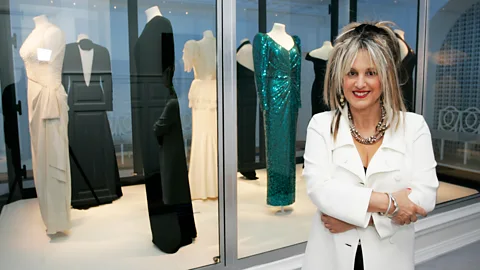 Getty Images
Getty Images“She was naïve, and so were we, so in that way we were very well matched. She wasn’t aware of the rules, and nor were we, we just did our thing. We were into drama and theatrics and there was a sense of freedom about it, to do whatever we wanted to do.”
Lady Diana, as she was then, was soon seen in a black Emanuel gown on her first official outing as Prince Charles's fiancée – and from that moment the designers were in the spotlight. By the time the wedding took place in 1981, Diana was, as Emanuel puts it, “the most famous woman in the world.”
“Every royal bride has influence,” says the designer, and the Diana wedding dress started a massive trend in bridal wear for ruffles and tulle, a dramatic departure from the more conventional, stiff, A-line creations seen before. “It was naivety, not actively rebellious. We all had a fabulous time creating it, and there was no-one who could stop us. She was the best collaborator, a willing partner in making her dream dress to create something that would make people gasp. It was the ultimate princess dress, which, looking back, is poignant.
 Getty Images
Getty Images“Nothing compares to that. It’s the combination of Diana’s story, how the wind caught the veil when she went up the steps to St Paul’s, that kiss on the balcony, they were amazing visuals. There’s a magic about that moment. It resonates in people’s hearts. It was a very happy day for her.”
Power dressing
As Cathy Kasterine puts it: “It was a moment… But it wasn’t just the dress, it was her in the dress. She was this very shy, virginal bride. And all the body language – the great big eyes peeking out from behind her fringe.” The run-up to the wedding had set the tone – with back-lit images of the young Lady Diana, as Kasterine puts it: “with armfuls of children in the nursery [where she worked].
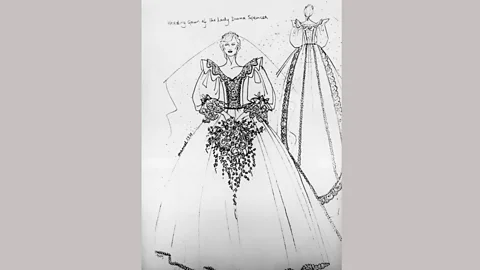 Getty Images
Getty Images“She was a real-life princess. In those days because of the protocol the bride had to be a virgin and had to be from a certain class – she was plucked from this bubble of the aristocracy, and that dress provided her entrance into her new life. It was fittingly extraordinary, to have a dress that was so bold, so huge and such a statement. It was innocent-looking but also powerful, she was going to go for it. It was the precursor to who she really was, and to the power that she developed. You were never going to forget it. When Fergie tried a similar look, it didn’t really work. It was the start of Diana’s reign.”
And there was another aspect to it. “It was also protection,” says Kasterine. “The dress carried her, like a holding field, she was held by it and the people who made it, the Emanuels, who were very ive of her.” And of course, looking back, the whole event resonates with poignancy – a fairytale wedding dress but, tragically, very much without the fairytale ending.
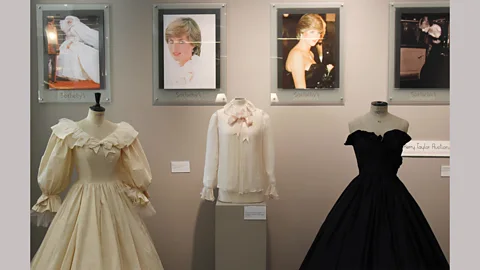 Getty Images
Getty ImagesThe famous bridal gown, and other Emanuel designs – including the much-imitated pale-pink, pie-crust collared silk-chiffon blouse – helped provide inspiration for a generation of young women. Kasterine, who was a schoolgirl at the time, recalls the impact of Diana’s outfits. “I don’t think she knew it, she just looked extraordinary. And like all alluring characters, people want to morph into that. Whether it’s Kim Kardashian or Kate Moss, they project a longing for whatever fantasy it is people are carrying.”
For the Emanuels, it was a moment that has been hard to beat. “That created us,” says Elizabeth. “It would take a lot to top that. Nothing compares to that.” And like her designs, Emanuel’s career has also been full of drama.
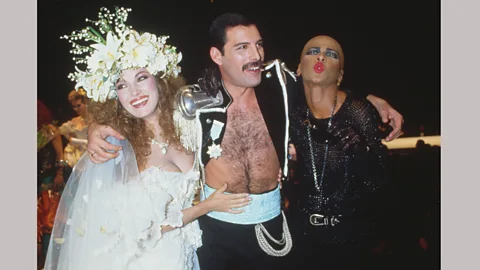 Getty Images
Getty ImagesThere have been ups and downs for the pair since then. The couple separated in 1990, later divorced after their label ran into financial trouble, and there followed various business woes and challenges – including at one point a court case. Her advice to designers starting out? “Keep your trademark as close as possible. I lost my name so I know how valuable it is to have. And most important is working with people who you trust.” Her career has been “a bit of a rollercoaster”.
But there have been highs for Elizabeth too, from deg for Ballet Rambert and the costumes for Frankenstein, the Modern Prometheus for the Dutch National Ballet, to creating the uniforms for the crew of Virgin Airlines. She also designed for other iconic figures including Joan Collins and Elizabeth Taylor. Earlier this year, two of her dresses were seen on the red carpet at the Oscars.
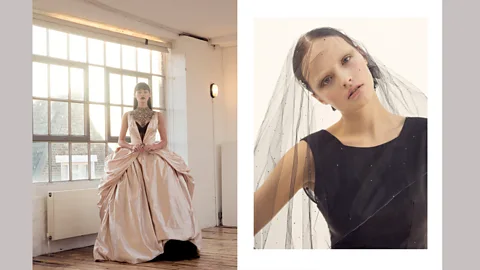 Markus Lambert/ Elizabeth by Elizabeth Emanuel
Markus Lambert/ Elizabeth by Elizabeth EmanuelOn the subject of more recent royal wedding dresses, she says simply: “I think we need to bring back the drama.” Something she has certainly done with her new couture collection, Paris 1902. “I want these things to be around for a long time,” she says. “It’s not cheap, quick fashion, I think of it more like an artwork. If I hadn’t done fashion I would probably have done costume design. With this collection you can be the star of your own movie.” The current collection is all finished by hand, “every item is unique”, including a ‘Romeo shirt’ in georgette and inspired by the ballet, with black tros. “Very androgynous,” as she puts it.
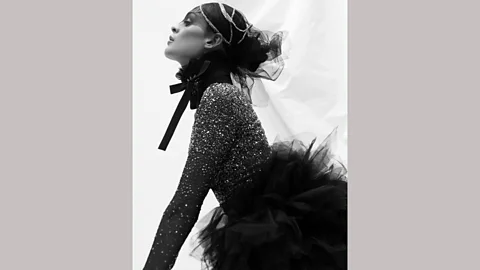 Markus Lambert/ Elizabeth by Elizabeth Emanuel
Markus Lambert/ Elizabeth by Elizabeth EmanuelWould she describe herself as a resilient person? “I must be,” she says. “I’m still here. It’s exciting and I feel my best work is to come. It’s hard to believe that it’s all one long line from 1981 to now, with all the accumulated experience. You know in the book Interview with a Vampire, where he has picked up all these different styles and all this knowledge. It’s a bit like that, where I’ve picked up so much that’s in my head, and I’m taking all that and creating something new.”
The collection Elizabeth, Paris 1902 is available now.
If you would like to comment on this story or anything else you have seen on BBC Culture, head over to our Facebook page or message us on Twitter.
And if you liked this story, sign up for the weekly bbc.com features newsletter, called “If You Only Read 6 Things This Week”. A handpicked selection of stories from BBC Future, Culture, Capital and Travel, delivered to your inbox every Friday.
